

Home → Inside Info → RB Freebies →
CENT-sitivity!
CENT-sitivity!
Copyright � 2005 by Ron Bauer
This is not only a unique handling for the Copper/Silver Transposition with a penny and a silver dollar, but it's surely the most startling way of presenting it. There seems to be no trickery because the misdirection for switching one coin for another is integrated into the easy to follow presentation. Ron Bauer kept CENT-sitivity! a closely guarded secret for over thirty-five years, and avoided using it if any magicians were around. Now, though, he is releasing it FREE for the magic community to amuse and amaze their informal audiences.
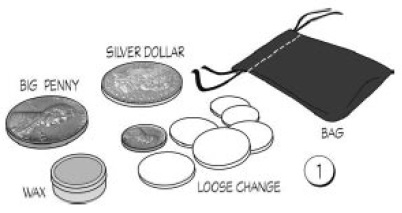
PROPS (FIG. 1)
- Silver Dollar
- Dollar-size Copper Penny
- Copper penny
- A small bag or coin purse
- Some pocket change
- Magician's Wax
NOTES ON PROPS
If you can get one, I recommend you use either a 1878 or 1921 Morgan dollar. These are the first and the last years of minting the 90% SILVER (and 10% licorice) coins. I prefer these because of the story possibilities, e.g., "This is one of the last of the Morgan dollars. In 1921, the government changed to the Peace dollar." Who knows. Someone might even be interested in such trivia. Actually, I really can't imagine that using a Peace or an Eisenhower dollar would change the effect.
PREPARATION AND SET-UP
A Morgan silver dollar has extra intrigue value if you carry it in one of those little gray jewelry pouches designed for small silver items. Whatever size bag you use, it shouldn't be too large. I use a small drawstring bag with just enough room to carry all the props including a small container of magician's wax. Before your performance, you can simply dump and distribute everything but the Silver Dollar.
The pocket change is made up of five or six small denomination coins, quarters, nickels, dimes, but only one penny.
 Use one of the quarters and the penny to make up the
"Quarter-Penny Assembly."
Use one of the quarters and the penny to make up the
"Quarter-Penny Assembly."
The penny, by the way, should match the big penny, each having a patina produced by age and use. It makes a good contrast to the silver dollar, which should be polished.
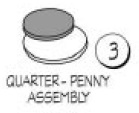 Apply some HARD (not soft) magician's wax to about a third
of the penny's surface. (FIG. 2) Attach the waxed section to a
quarter so their edges overlap. (FIG. 3)
Apply some HARD (not soft) magician's wax to about a third
of the penny's surface. (FIG. 2) Attach the waxed section to a
quarter so their edges overlap. (FIG. 3)
Drop this gimmick and the rest of the change into your jacket pocket. I prefer this to the trouser pocket because it's easier to get at. The wax isn't absolutely essential to the trick, but it makes the handling much cleaner as you will see.
Finally, drop the BIG PENNY into your right jacket pocket with the rest of the change. You could isolate it by using your ticket pocket, but it might delay the handling.
STEP-BY-STEP PROCEDURE
- Show the little bag by swinging it from its strings. (FIG. 4)
- Remove the DOLLAR, and put the bag onto the table. Place the DOLLAR onto to it for a nice display. (FIG. 5)
- Pick up the DOLLAR, and turn it slowly to show the detail of the engraving work on both sides.
- Display your LEFT hand palm-up to show the spectator what to do.
- As soon as she holds out her palm-up right hand, place the DOLLAR on the fingers of YOUR palm-up left hand, then close it to show her what she's to do.
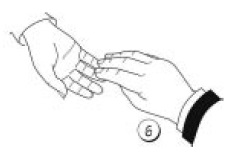 This time you put the DOLLAR onto HER fingers,
but do it as follows. As you open your left hand,
immediately cover the DOLLAR with your palm-down
right, i.e., screen the DOLLAR from the audience's view
with your right fingers as you slip your right thumb
beneath it so you can pick it up. (FIG. 6) As soon as she
begins to close her fingers around the DOLLAR, assist her in turning it over
over.
This time you put the DOLLAR onto HER fingers,
but do it as follows. As you open your left hand,
immediately cover the DOLLAR with your palm-down
right, i.e., screen the DOLLAR from the audience's view
with your right fingers as you slip your right thumb
beneath it so you can pick it up. (FIG. 6) As soon as she
begins to close her fingers around the DOLLAR, assist her in turning it over
over.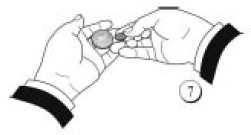 As soon as she opens her hand to display the DOLLAR, pick it up the with
your right hand as in Step 5, i.e., cover the DOLLAR with your right fingers as
you slip your right thumb beneath it. Pick it up, and place it on the fingers of
your palm up left hand for display.
As soon as she opens her hand to display the DOLLAR, pick it up the with
your right hand as in Step 5, i.e., cover the DOLLAR with your right fingers as
you slip your right thumb beneath it. Pick it up, and place it on the fingers of
your palm up left hand for display.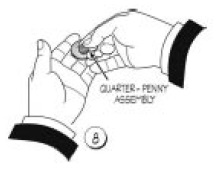 Reach into your right pocket, and quickly locate
by touch the Quarter-Penny Assembly. Grab it and
several other coins, and bring them out of your
pocket. Let the audience see the handful of change
in your right hand as you maneuver the penny end
of the Quarter-Penny Assembly to the tips of your
right fingers with your right thumb. (FIG. 7)
Reach into your right pocket, and quickly locate
by touch the Quarter-Penny Assembly. Grab it and
several other coins, and bring them out of your
pocket. Let the audience see the handful of change
in your right hand as you maneuver the penny end
of the Quarter-Penny Assembly to the tips of your
right fingers with your right thumb. (FIG. 7)- Apparently, push the penny onto the DOLLAR with your right thumb tip. (FIG. 8) Actually, press its edge against the center of the DOLLAR while pressing the quarter against your right fingers. The penny will pop free. (FIG. 9) As you tap the penny with your left thumb for emphasis, casually press it against the DOLLAR with your left thumb tip so it will adhere.
- Close your left hand over the coins quickly so nobody notices the penny is stuck to the DOLLAR.
- Casually drop the remaining change into your right jacket pocket secretly securing the BIG PENNY.
- Bring your right hand out of your pocket with the BIG PENNY hidden
behind your fingers clipped between the edges of your first
and fourth fingertips. (FIG. 10) This is like the Front part
of the Front and Back Palm of a coin.
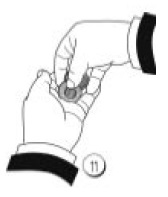 Actually, you can just
hold it in place with the tip of your right thumb. Open your
left hand enough so you can pick up the DOLLAR and PENNY
with your right hand. By doing this, you'll
automatically and secretly add the BIG PENNY
to the group. Position your right thumb tip
against the PENNY. (FIG. 11) "Talking" is covered by the fact
that the audience knows there are TWO coins. Display your left
hand palm-up to show the spectator what to do. Relax your
right hand to help avoid anyone seeing the hidden BIG PENNY.
Actually, you can just
hold it in place with the tip of your right thumb. Open your
left hand enough so you can pick up the DOLLAR and PENNY
with your right hand. By doing this, you'll
automatically and secretly add the BIG PENNY
to the group. Position your right thumb tip
against the PENNY. (FIG. 11) "Talking" is covered by the fact
that the audience knows there are TWO coins. Display your left
hand palm-up to show the spectator what to do. Relax your
right hand to help avoid anyone seeing the hidden BIG PENNY. - As you gesture with your empty left hand, casually adjust DOLLAR into alignment with the BIG PENNY. (FIG. 12)
- Put the group of three coins into your left hand closing it to hide the presence of the BIG PENNY. (FIG. 13)
- Reach into your partially closed left hand with your right fingers, and take the BIG PENNY, gripping as previously established, closing your left hand to hide the remaining coins. (FIG. 14)
- Place BIG PENNY onto the spectator's fingers. (FIG. 15) Then close them around it, and turnover her hand so the audience doesn't see what she has.
- Gesture with your right hand to make sure everyone knows it's empty as you keep your closed left hand in plain view from now on. (FIG. 16)
- As soon as she answers: "The DOLLAR."
- Look at her as though you know something she doesn't. (It's up to you how to pull that off!)
- Open your left hand to reveal DOLLAR on your fingers. (The PENNY is stuck to its underside!)
- She opens her hand to reveal the BIG PENNY.
- Retrieve the BIG PENNY, and place it on the outstretched fingers of your left hand with the DOLLAR, and let the audience see that both hands are otherwise empty.
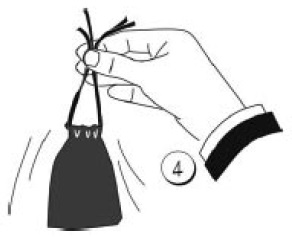 "You've heard that the hand is quicker than the eye? Of course it is! The sense
of SIGHT is the EASIEST one to deceive... The sense of TOUCH? That's not so
easy. I don't know whether you know this or not, but at MAGIC SCHOOL we
learn to fool people ONE SENSE at a time... and,
they start us with TOUCH because that's the
HARDEST one to fool... In fact, just to stay in
practice, I still carry my FOOL THE SENSE OF
TOUCH TEST KIT..."
"You've heard that the hand is quicker than the eye? Of course it is! The sense
of SIGHT is the EASIEST one to deceive... The sense of TOUCH? That's not so
easy. I don't know whether you know this or not, but at MAGIC SCHOOL we
learn to fool people ONE SENSE at a time... and,
they start us with TOUCH because that's the
HARDEST one to fool... In fact, just to stay in
practice, I still carry my FOOL THE SENSE OF
TOUCH TEST KIT..."
"Interested in seeing how good I'm getting at this? (PAUSE) Okay. You talked me into it. Here's something you don't see every day... unless you're a COIN COLLECTOR, that is..."
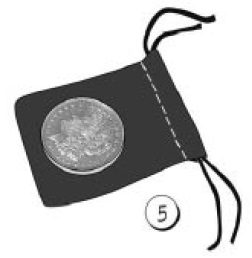 RB COMMENTS: Have you ever noticed the
apparent care, almost reverence, a jeweler gives
to the reveal of an object? It's a presentation. This
little ritualistic behavior is good to emulate.
RB COMMENTS: Have you ever noticed the
apparent care, almost reverence, a jeweler gives
to the reveal of an object? It's a presentation. This
little ritualistic behavior is good to emulate.
"This is a SILVER DOLLAR... Of course you KNOW it's a SILVER DOLLAR. You can SEE it. But, you may or may not be able to recognize it by TOUCH ALONE... despite its weight and all those beautiful engravings..."
"Before I test you, I want you to hold it in your hand. Not both hands, just your RIGHT ONE..."
RB COMMENTS: You show the spectator how you want her to hold out her hand before you begin the trick. This is to avoid a situation in which you get a spectator who can't understand or decides to be hesitant. Such delays caused by a spectator who balks as you go into an "in their hands" effect can throw off your misdirection and the pace of your performance.
"Okay. I'm going to place the DOLLAR on your fingers, and I want you to close your hand like this, and turn it over..."
"Now, get the FEEL OF IT... The point is to make it part of your SENSORY MEMORY... The next time I have you hold a coin, you'll know WITHOUT LOOKING, by TOUCH ALONE, if it's the SILVER DOLLAR. Right?"
RB COMMENTS: Whenever you pick up the DOLLAR with your right hand, always do it the same, specific way, i.e., begin by covering it with your right fingers. This deliberately cozy handling will arouse suspicion that you're up to something... in case anyone trusts you anyway! That's okay because it's visual preparation for later swindling. Additionally, "relax" your left hand, turning it palm inward, as soon as you take the DOLLAR. Sometimes the "wise ones" suspect you might still have it there. When they later see they were wrong, you are ahead of the game.
"Of course, using just this one coin would be too easy. I'm going to use TWO COINS, and you're going to tell me which one is THIS DOLLAR. Now, that might be difficult if I was using TWO SILVER DOLLARS. So, I won't do that. Give that back, and I'll show you the OTHER coin we'll be using..."
"Let's see... I've got some loose change here... I want give you every chance to keep me from fooling your sense of TOUCH... so, how about if I use this..."
"...PENNY."
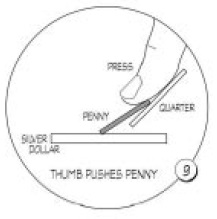
"You can tell the difference between this SILVER DOLLAR and this PENNY. Right? Of course, that's because you're using the sense of SIGHT. But I'm going to fool your sense of TOUCH, not SIGHT. That means NO PEEKING at the coins..."
RB COMMENTS: Use trouser pocket if you wish. Just remember that if you dawdle around trying to find the big penny after returning the change, you risk someone getting suspicious! Dropping something in one's pocket rarely requires any hesitation.
"By the way, you already know what a PENNY feels like. Right? Of course..."
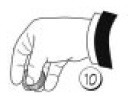
"Okay. Then we're ready to go. Put your RIGHT hand out like this... Just like you did before..."
"I'm going to give you one of these, but I don't want you to see which one..."
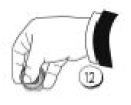 "So, AVERT YOUR EYES... You can close them if you want to... Either way, DON'T
PEEK... I don't want you to see which one I'm giving you..."
"So, AVERT YOUR EYES... You can close them if you want to... Either way, DON'T
PEEK... I don't want you to see which one I'm giving you..."
"I'm taking one of the coins out of my hand... and putting it into yours..."
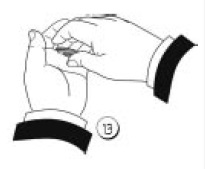
"Everyone else can watch to make sure I'm not pulling out any more SILVER DOLLARS... We're just using these two coins..."
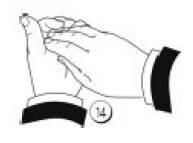 RB COMMENTS: Because you've conditioned them to
this handling, it won't cause suspicion. Besides that,
they're not supposed to be PEEKING!
RB COMMENTS: Because you've conditioned them to
this handling, it won't cause suspicion. Besides that,
they're not supposed to be PEEKING!
"Now, whatever you do... DON'T OPEN YOUR HAND UNTIL I SAY TO... Okay?"
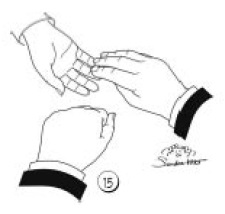 "Which one of the coins do you think you're holding?
Remember, the only sense you can use is TOUCH... and
I am FOOLING your sense of TOUCH right now! [BEAT]
So, I'll ask you again. Which one do you believe you're
holding?"
"Which one of the coins do you think you're holding?
Remember, the only sense you can use is TOUCH... and
I am FOOLING your sense of TOUCH right now! [BEAT]
So, I'll ask you again. Which one do you believe you're
holding?"
"No. You've got the PENNY. I'm making you THINK you've got the DOLLAR with my magical power! Don't look... Just tell me if you STILL believe you've got the DOLLAR?"
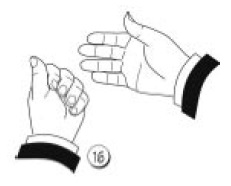 "This is how I passed the FOOL THE SENSE OF TOUCH TEST, folks. She NEVER
had the DOLLAR. But, I made her THINK so by making that PENNY really BIG!
[BEAT] I've got the DOLLAR..."
"This is how I passed the FOOL THE SENSE OF TOUCH TEST, folks. She NEVER
had the DOLLAR. But, I made her THINK so by making that PENNY really BIG!
[BEAT] I've got the DOLLAR..."
"Open your hand and show everybody the BIG PENNY!"
"If you wonder how the LITTLE PENNY got so BIG, ask them. THEY were WATCHING!"
Drop the BIG PENNY on the table for everyone to ogle as you drop the DOLLAR with its hidden BIG PENNY into the bag.
(TAG LINE): "You know, with a penny that BIG, this trick ought to make MORE CENTS!"
RB COMMENTS: PLEASE don't "magically" change the big penny back to a standard penny! Even if you come up with some really clever way of justifying the transformation... don't do it. You're almost sure to have a weaker reaction... I think it's called: anticlimax!
If anyone requests you give them the BIG PENNY as a souvenir, and it often happens, tell them: "It really won't do any good. In a few minutes it will be back to its normal size like all the other pennies!"
Copyright � 2005 by Ron Bauer